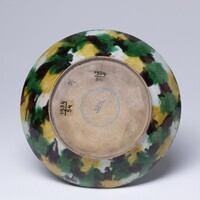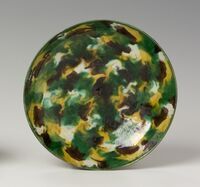Bord
Objectnummer1934.0054
TitelBord
Vervaardigeronbekend
BeschrijvingBord van Chinees porselein op voetrand; steile, rond gebogen wand. Boven en onderzijde versierd met groen, geel en bruin glazuur op biscuit. De bodem is ongeglazuurd en gemerkt met een gegraveerd en blauw omlijnd alsemblad in een eveneens gegraveerde dubbele cirkel.
Hoewel van verschillende afkomst past het bord uitstekend bij een kom uit de collectie van het Groninger Museum #1937.1057. Dit type versiering op biscuit wordt 'tiger skin', 'ei-en-spinazie' of 'schildpad' genoemd. In feite is het een voortzetting van, de meer verfijndere, 17e eeuwse 'Brinjal' kommen. 'Ei-en-spinazie' decoratie was rond 1900 erg populair in het Westen, en er zijn imitaties geproduceerd. Of het hier een imitatie betreft is niet duidelijk.
saucer on footrings with spreading sides. The inside and the outside are painted with patches of green and yellow enamel and white glaze on the biscuit. The base of the saucer is unglazed and is marked with an incised and blue-lined artemisia leaf in a similarly engraved double circle.
Although having different provenances, this saucer is well matched to a bowl in the collection of the Groninger Museum (# 1937.1037). This type of enamelling on the biscuit is traditionally called ‘tiger skin’, ‘egg and spinach’ or ‘tortoise shell’. In fact, it is a direct continuation of 17th-century ‘brinjal’ bowls, which are more refined (ref. Ayers). According to Adhyatman, such bowls were common in Sumatra (ref.). This ‘egg and spinach’ effect was also very popular for a while in the West around 1900 and imitations were made; whether this is such a later copy is not clear.
Hoewel van verschillende afkomst past het bord uitstekend bij een kom uit de collectie van het Groninger Museum #1937.1057. Dit type versiering op biscuit wordt 'tiger skin', 'ei-en-spinazie' of 'schildpad' genoemd. In feite is het een voortzetting van, de meer verfijndere, 17e eeuwse 'Brinjal' kommen. 'Ei-en-spinazie' decoratie was rond 1900 erg populair in het Westen, en er zijn imitaties geproduceerd. Of het hier een imitatie betreft is niet duidelijk.
saucer on footrings with spreading sides. The inside and the outside are painted with patches of green and yellow enamel and white glaze on the biscuit. The base of the saucer is unglazed and is marked with an incised and blue-lined artemisia leaf in a similarly engraved double circle.
Although having different provenances, this saucer is well matched to a bowl in the collection of the Groninger Museum (# 1937.1037). This type of enamelling on the biscuit is traditionally called ‘tiger skin’, ‘egg and spinach’ or ‘tortoise shell’. In fact, it is a direct continuation of 17th-century ‘brinjal’ bowls, which are more refined (ref. Ayers). According to Adhyatman, such bowls were common in Sumatra (ref.). This ‘egg and spinach’ effect was also very popular for a while in the West around 1900 and imitations were made; whether this is such a later copy is not clear.
Datum 1700 - 1800
Vervaardiging periode18e eeuw
Objectnaamborden (vaatwerk)
Objectcategorieoosterse keramiek
Formaat
- rand schotel diameter: 20.70 cm
voetring schotel diameter: 13.00 cm
schotel geheel hoogte: 4.20 cm
Credit lineGroninger Museum. Schenking van de heer F.H. Jansenius de Vries, Warffum (1934)





